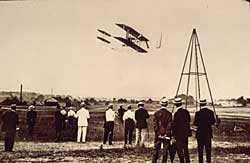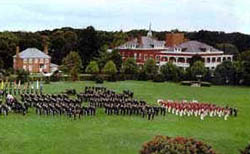
The first military airplane in the world, built by the Wright brothers for the Army Signal Corps, made its first flight at Fort Myer, Virginia, in September 1908. The Army established military aviation in the Signal Corps in August 1907 because observation and reconnaissance were the only functions for the airplane known to the military at that time. In December 1907, the Chief Signal Officer requested bids for a flying machine with requirements generally thought to be impossible. Many in the aeronautical community predicted that the Army would not receive any bids, but the Wright brothers signed a contract on February 10, 1908, and delivered the airplane to Fort Myer in August 1908. The specification required the "Heavier-than-air Flying Machine" to carry two people, fly 40 miles per hour, make a one-hour endurance flight and be portable by Army wagons. Flying instruction for two officers was also required.
Orville Wright was the pilot for the flights required to demonstrate performance. Less than a thousand people witnessed the first flight at Fort Myer on September 3, 1908, because the general public was still doubtful that powered flight had been achieved. Orville's subsequent flights during the next two weeks were watched by thousands, and finally convinced the American public that "man could fly." The flights at Fort Myer established a number of new world records for endurance, but the last flight on September 17 ended in disaster. A crack in the right propeller caused the plane to crash, seriously injuring Orville and killing Lt. Thomas E. Selfridge. Delivery of the new flying machine was postponed until the following summer, when Orville made additional demonstration flights at Fort Myer in a Wright A plane, an improvement of the 1908 design. The Army formally accepted Signal Corps Airplane No. 1, the world's first military airplane, on August 2, 1909. The Wright brothers fulfilled their contract in October and early November when Wilbur Wright provided flying instruction for three Army officers at College Park, Maryland.

Fort Myer had been established as Fort Whipple during the Civil War in 1863. It was renamed for Brigadier General Albert J. Myer, who established the Signal School of Instruction for Army and Navy Officers here in 1869. By the turn of the 20th century, the military had determined that Fort Myer should become a permanent army post, and an extensive building program was initiated. The buildings of the historic district date to this period of construction and include commodious senior officers' quarters known as "Generals' Row" that became home to the Army Chiefs of Staff including Generals Leonard Wood, Douglas MacArthur, George C. Marshall, Dwight D. Eisenhower and William Westmoreland. Fort Myer is also the home of the Air Force Chief of Staff and the Chairman of the Joint Chiefs of Staff.
The Fort Myer Historic District, a National Historic Landmark, is roughly bounded by Arlington Blvd (U.S. 50), Clarendon Blvd. and Arlington National Cemetery. Due to heightened security, this active base is not open to the public. For more information visit the base's website.
Visit the National Park Service Travel American Aviation to learn more about Aviationrelated Historic Sites.
Last updated: September 3, 2017
